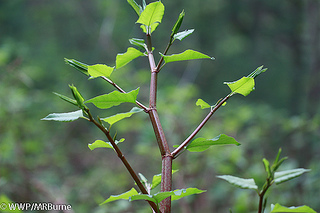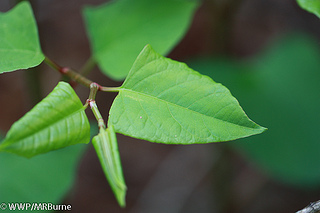Japanese Knotweed
(Fallopia japonica)
Family: Buckwheat Family (Polygonaceae)
Native Range: East Asia
 Japanese knotweed is a tall herbaceous perennial that can grow to over 10 feet in height. As with all members of this family, the base of the stem above each joint is surrounded by a membranous sheath.
Japanese knotweed is a tall herbaceous perennial that can grow to over 10 feet in height. As with all members of this family, the base of the stem above each joint is surrounded by a membranous sheath.
The stems are smooth, stout and swollen at joints where the leaf meets the stem. Although leaf size may vary, leaves are normally about 6 inches long by 3 to 4 inches wide, broadly oval to somewhat triangular and pointed at the tip. Minute, greenish-white flowers occur in branched sprays in summer that develop into small winged fruits. Seeds are triangular, shiny, and very small, about 1/10 inch long.
Look-alikes
- Virginia knotweed (Tovara virginica)
- prince’s feather (Polygonum orientale)
- giant knotweed (Polygonum sachalinense, non-native)
Note that the giant knotweed (Polygonum sachalinense) can grow taller than Japanese knotweed, and has much larger leaves (up to 12″ long). The upper surface of Japanese knotweed has an extremely fine-sandpaper feel in contrast to the fine-leather feel of giant knotweed.
Ecological Threat
Japanese knotweed spreads quickly to form dense thickets that exclude native vegetation and greatly alter natural ecosystems. It poses a significant threat to riparian areas, where it can survive severe floods and rapidly colonize scoured shores and islands. Once established, populations are extremely persistent.
Distribution and Background
 Japanese knotweed was probably introduced to the U.S. in the late 1800’s. Also known as crimson beauty, Mexican bamboo, Japanese fleece flower, or Reynoutria, it was first introduced as an ornamental and has also been used for erosion control and landscape screening. It is now found throughout the eastern U.S., in many western states, and in Alaska, which has few other exotic invasive plants to date.
Japanese knotweed was probably introduced to the U.S. in the late 1800’s. Also known as crimson beauty, Mexican bamboo, Japanese fleece flower, or Reynoutria, it was first introduced as an ornamental and has also been used for erosion control and landscape screening. It is now found throughout the eastern U.S., in many western states, and in Alaska, which has few other exotic invasive plants to date.
Japanese knotweed can tolerate a variety of adverse conditions including full shade, high temperatures, high salinity, and drought. It is found near water sources, such as along streams and rivers, in low-lying areas, waste places, utility rights-of-way, and around old homesites. It can quickly become an invasive pest in natural areas after escaping from cultivated gardens.
Biology and Spread
Japanese knotweed spreads primarily by vegetative means with the help of its long, stout rhizomes. It is often transported to new sites as a contaminant in fill-dirt. Seeds are frequently distributed by water, and carried to a lesser extent by the wind. Discarded cuttings are common routes of dispersal from urban areas.
Alternative Plants (Alternative Native Species)
Many attractive native herbs and shrubs are available that make excellent alternatives to Japanese knotweed.
- New England Aster (Aster novae-angliae)
- Blue False Indigo (Baptisia australis)
- Sweet Joe-Pye-Weed (Eupatorium purpureum)
- Queen-of-the-Prairie (Filipendula rubra)
Whenever possible, use as alternatives plant species that are native and adapted to the ecological region where you live. They will be more valuable to the wildlife species that have evolved with them and depend upon them for food and shelter. Check with your local native plant society for recommendations and sources of native plants.
Management Options
Grubbing is effective for small initial populations or environmentally sensitive areas where herbicides cannot be used. Remove the entire plant including all roots and runners.
For disposal options, refer to the control methods and disposal options page.
Plant Control
Manual and chemical control methods are effective in removing and killing Japanese knotweed. A combination of methods often yields the best results and may reduce potential impacts to native plants, animals and people. The method selected depends on the extent and type of infestation, the amount of native vegetation on the site, and the time, labor and available resources.
Biological
There are no biological controls available in the United States for this plant. However, in England, where Japanese knotweed is also a major plant pest, a sap-sucking insect was approved for release in 2010.
See http://news.bbc.co.uk/2/hi/8555378.stm.
Manual
Pull juvenile plants by hand depending on soil conditions and root development. Any portions of the root system not removed will potentially resprout. Collect and bag the plants and mature fruits and dispose of them in heavy garbage bags to prevent reestablishment.
Chemical
Caution: Applying herbicides to control invasive plants on property you do not personally own requires a pesticide applicator’s license issued by the state. A pesticide applicator’s license is required to use herbicides on public and private conservation lands.
Use this method in areas where plants are established within or around non-target plants or where vines have grown into the canopy. This treatment is effective at low temperatures as long as the ground is not frozen.Cut the stem about 2 inches above ground level. Using a drip bottle, immediately apply a 25% solution of glyphosate (such as Roundup®, or use Rodeo® if applying in or near wetland areas) or triclopyr (such as Garlon) and water into the stem.A subsequent foliar application of glyphosate may be required to control new seedlings and resprouts.Foliar application
Use this method to control large populations. It may be necessary to precede foliar applications with stem treatments to reduce the risk of damaging non-target species.
Apply a 2% solution of glyphosate or triclopyr and water to thoroughly wet all foliage. Do not apply so heavily that herbicide will drip off leaves.
If you use a wetland-formulated herbicide such as Rodeo, a 0.5% non-ionic surfactant is recommended in order to penetrate the leaf cuticle, and ambient air temperature should be above 65 ºF.
Any activities in wetlands (from removing invasives by hand or by applying herbicides) may require a special permit under the Wetlands Protection Act and/or your local bylaws. Be sure to contact your local Conservation Commission before you act.
Notice: Mention Of Pesticide Products On This Web Site Does Not Constitute Endorsement Of Any Material.
More Information
For more information on invasive species in Massachusetts, refer to the Massachusetts Prohibited Plant List.
Preventing the Spread of Japanese Knotweed– NH Department of Agriculture
Managing Japanese Knotweed and Giant Knotweed on Roadsides– Penn State Roadside Research Project, Department of Horticulture
Managing Japanese Knotweed– Penn State Vegetation Management, Department of Horticulture
Time to kill the beast – Importance of taxa, concentration and timing during application of glyphosate to knotweeds – Czech University of Life Sciences
Optimising physiochemical control of invasive Japanese knotweed – Swansea University
Author
Tom Remaley, Great Smoky Mountains National Park, Gatlinburg, TN
References
Ahrens, J.F. 1975. Preliminary results with glyphosate for control of Polygonum cuspidatum . Proceedings of the Northeast Weed Control Conference 29:326.
Child, L.E., L.C. De Wall, P.M Wade, J.P. Palmer. 1992. Control and management of Reynoutria species (knotweed). Aspects of Applied Biology 29:295-307.
Figueroa, P.F. 1989. Japanese knotweed herbicide screening trial applied as a roadside spray. Proceedings of the Western Society of Weed Science 42:288-298.
Hirose, T., K. Kitajima. 1986. Nitrogen uptake and plant growth. I. Effect of nitrogen removal on growth of Polygonum cuspidatum Ann. Bot. 58(4):479-486.
Jennings, V.M, R.S. Fawcett. 1977. Weed control: Japanese polygonum (Polygonum cuspidatum Sieb. and Zuce.). PM Iowa State Univ. Science Technol. Ames. Coop. Ext. Serv. 762, 2.
Pridham, A.M.S., A. Bing. 1975. Japanese bamboo (Polygonum cuspidatum, Polygonum sachalinens). Plants Garden 31(2):56-57.
Radford, A. E., H.E. Ahles, C.R. Bell. 1968. Manual of vascular flora of the Carolinas. Chapel Hill, NC: The University of North Carolina Press, 1183.
Randall, J.R. and J. Marinelli. 1998. Invasive Plants: Weeds of the Global Garden. Brooklyn Botanic Garden, Handbook No. 149, p. 77.
Scott, R., R.H. Marrs. 1984. Impact of Japanese knotweed and methods of control. Aspects of Applied Biology 291-296.
Smith, R.C. 1990. Polygonum cuspidatum var. compactum American Nurseryman 172(2):142.
Swearingen, J. 2009. WeedUS Database of Plants Invading Natural Areas in the United States: Japanese Knotweed (Polygonum cuspidatum) http://www.invasive.org/weedus/subject.html?sub=3414.
The Nature Conservancy. Japanese Knotweed: Element Stewardship Abstract. In: Wildland Weeds Management & Research Program, Weeds on the Web.
USDA, NRCS. 2009. The PLANTS Database http://plants.usda.gov National Plant Data Center, Baton Rouge, LA 70874-4490 USA.
Plant Conservation Alliance, Alien Plant Working Group https://www.invasive.org/species/weeds.cfm